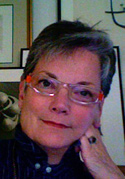 |
→ March 2007 Contents → Column
|
On Russell Lee
March 2007
|
 |
|
Russell Lee's great photographic work did not start with the much-celebrated Farm Security Administration of the late-1930s nor did it stop there. He maintained his consideration of the human condition from first to last.
In the book Russell Lee Photographs, he is released from being another name on a list of photographers to set the record straight: his genius embraced many styles of documentary photography, each one used to tell a different story effectively.
This project undertaken by Linda Peterson, head of Photographic Archives at the Center for American History, University of Texas at Austin, with Lee's friend and colleague J.B. Colson, is a service to the photography community for which we should all be grateful. We are allowed, at long last, to see the vibrant range of Lee's work.
A photograph in 1936 reveals a nighttime view of a New York City sidewalk. A blind man plays his fiddle, tin cup fastened to his coat; an old woman on crutches is near him. Men in dark coats surround them looking elsewhere, ignoring the sound of the violin. Overhead an illuminated marquee seems to blare, "FLOODS KILL HUNDREDS IN EAST COMPLETE FILMS NOW SHOWING." Sounds no one listens to, films the fiddler cannot see, tragedy announced to the blind and indifferent—irony abounds. The rich dark tonalities in the image bring everything together.
Photographs from 1959 in state hospitals show a delicate touch. Lee is not interested in showing specific faces but in an overall mood and affecting circumstance. Generally dark with muted light coming from behind patients, the prints communicate institutional isolation and personal despair. There is no sense that the photographer is pointing at people to lay bare their particular weaknesses.
Lee also captured radiant landscapes in Italy and the interactions of people talking, gesturing and bargaining in Italian cities. His sense of timing here and elsewhere is exquisite. A certain look, a mild embarrassment or a shrewd point made: all come to life in these photographs.
In short, Russell Lee was a master of the medium whose images now appear—many for the first time— beautifully reproduced in this magnificent book.
© Marianne Fulton
|
|
Back to March 2007 Contents
|
|